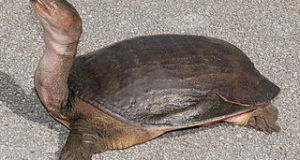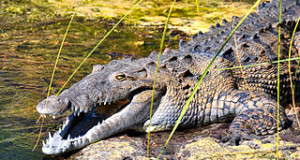 I’ve been very fortunate in having spent many years working with Crocodilians in both captivity and the wild while remaining (more or less!) intact in the process. Today I’d like to introduce the Marsh Crocodile (Crocodylus palustris) and highlight a unique population that thrives in a most unexpected locale.
I’ve been very fortunate in having spent many years working with Crocodilians in both captivity and the wild while remaining (more or less!) intact in the process. Today I’d like to introduce the Marsh Crocodile (Crocodylus palustris) and highlight a unique population that thrives in a most unexpected locale.
Threats
Marsh Crocodiles, also known as Muggars, are equipped with immensely broad snouts (the croc world’s widest) and may reach 16 feet in length. Their large size and propensity to colonize canals and other man-made water bodies renders them a threat to people in some areas. Attacks are not unknown – this, along with a fondness for livestock and commercially important fish, has doomed several populations to extinction.
The IUCN classifies the species as “Vulnerable”. Fortunately, Muggars are farmed in some areas; this has lessened pressure on wild stock from skin traders. The population in Iran, which I’ll discuss in Part 2 of this article, is not disturbed and seems to be doing quite well.
Working with Muggars
I worked with a group of Muggars at the Bronx Zoo for quite some time. Like all crocs, they were amazingly aware of their surroundings and quick to respond to changes in their daily routine. If I followed the same procedure each day when working in their exhibit, the Muggars would predict my movements and stay out of my way. Two people entering the exhibit, however, meant trouble (they seemed to recall being restrained for vet exams) – and, as you can see from the accompanying photo, they were not shy abut charging in response.
I do not recommend keeping Crocodilians of any species as pets – but if you train as a professional zookeeper or field researcher there will be many exciting opportunities in store for you. Almost all species, from the small (by croc standards) Dwarf Caiman to the massive Salt Water Crocodile, are in deep trouble, and many zoos are expanding their breeding efforts – please see the photo of I and co-workers moving a highly endangered Indian Gharial for a sample of what may await you.
Further Reading
Please see this website for an interesting collection of Muggar news stories and research notes.
My visit with Gomek, the largest croc in captivity.
Video of a wild Marsh Crocodile, Sloth Bears and other creatures.
Marsh Crocodile Basking image referenced from wikipedia and originally posted by Karunakar Rayker
 That Reptile Blog – Reptile, Amphibian and Exotic Pet Care and Information
That Reptile Blog – Reptile, Amphibian and Exotic Pet Care and Information



